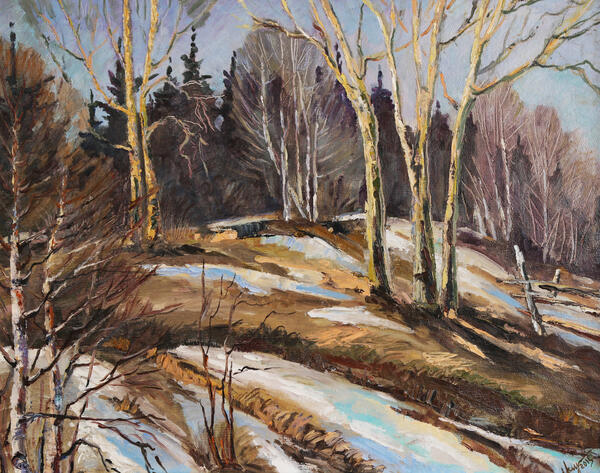Irina Rodionovna Zinatulina is a talented artist. Since 2010 she has been a member of Siberian Expanses, a regional group of artists. She has participated role in Beauties of the Kuzbass Summer, a plein-air painting competition, and also in local and regional exhibitions such as Salair Ridge and Golden Shoria.
Irina Zinatulina does most of her painting outdoors. Most of her paintings depict Siberia’s nature, in all its wistful beauty. The artist, with her gift for seeing poetry and beauty everywhere, expresses a sense of harmony and the calming influence of the natural world in her work.
Poplar Trees in Spring depicts an attractive spot in Mountain Shoria.
On the top of a hill, which almost scrapes the grey sky, a small copse has grown up, forming a dense wall. Among the dark green fir trees and the slender silver birches a graceful poplar spreads it branches out wide. These trees are considered to be a symbol of youth and nobility. In Irina Zinatulina’s painting they serve as a personification of rebirth and the renewal of nature.
In the foreground we see patches of earth, revealed by the melting snow. Dark earthy tones are dominant in this painting. The viewer’s attention is held by the clean white snow drifts, which contrast vividly with the richly- textured earth. Spring has already made its appearance — and can be felt in the fresh air and seen in the melting snow and in the warm sunlight that fills the scene.
For centuries the Shorians, or Kuznetsk Tatars, have lived in the land that the artist depicts in her work. These indigenous people had their own explanation for the rebirth of nature that comes after the end of winter. They believed that every spring the good spirits return to the Earth, and bring happiness with them. The dark, evil spirits then go away from human settlements and only return the next winter.
Spring in Mountain Shoria arrives at the end of March or beginning of April. In the Shorians’ folklore, the awakening of nature from its winter hibernation is sometimes announced by the lord of the mountains: ‘In spring, before the first leaves appear on the trees’ bare branches and the first blades of grass appear on the ground, the lord of the mountains calls. The same thing happens in autumn, when the withered grass collapses and the dry leaves fall from the trees. Then the ears of the mountains can hear better. And he calls again.’
In Mountain Shoria spring is out of step with the calendar. Spring here is particularly unpredictable: snowfalls can be followed by warm weather, and the warm spell interrupted by frosts or storms with torrential rain.
But in Western Siberia the reawakening of the land after winter is one of Nature’s most beautiful phenomena — and Irina Zinatulina has captured this moment on canvas superbly.
Irina Zinatulina does most of her painting outdoors. Most of her paintings depict Siberia’s nature, in all its wistful beauty. The artist, with her gift for seeing poetry and beauty everywhere, expresses a sense of harmony and the calming influence of the natural world in her work.
Poplar Trees in Spring depicts an attractive spot in Mountain Shoria.
On the top of a hill, which almost scrapes the grey sky, a small copse has grown up, forming a dense wall. Among the dark green fir trees and the slender silver birches a graceful poplar spreads it branches out wide. These trees are considered to be a symbol of youth and nobility. In Irina Zinatulina’s painting they serve as a personification of rebirth and the renewal of nature.
In the foreground we see patches of earth, revealed by the melting snow. Dark earthy tones are dominant in this painting. The viewer’s attention is held by the clean white snow drifts, which contrast vividly with the richly- textured earth. Spring has already made its appearance — and can be felt in the fresh air and seen in the melting snow and in the warm sunlight that fills the scene.
For centuries the Shorians, or Kuznetsk Tatars, have lived in the land that the artist depicts in her work. These indigenous people had their own explanation for the rebirth of nature that comes after the end of winter. They believed that every spring the good spirits return to the Earth, and bring happiness with them. The dark, evil spirits then go away from human settlements and only return the next winter.
Spring in Mountain Shoria arrives at the end of March or beginning of April. In the Shorians’ folklore, the awakening of nature from its winter hibernation is sometimes announced by the lord of the mountains: ‘In spring, before the first leaves appear on the trees’ bare branches and the first blades of grass appear on the ground, the lord of the mountains calls. The same thing happens in autumn, when the withered grass collapses and the dry leaves fall from the trees. Then the ears of the mountains can hear better. And he calls again.’
In Mountain Shoria spring is out of step with the calendar. Spring here is particularly unpredictable: snowfalls can be followed by warm weather, and the warm spell interrupted by frosts or storms with torrential rain.
But in Western Siberia the reawakening of the land after winter is one of Nature’s most beautiful phenomena — and Irina Zinatulina has captured this moment on canvas superbly.





